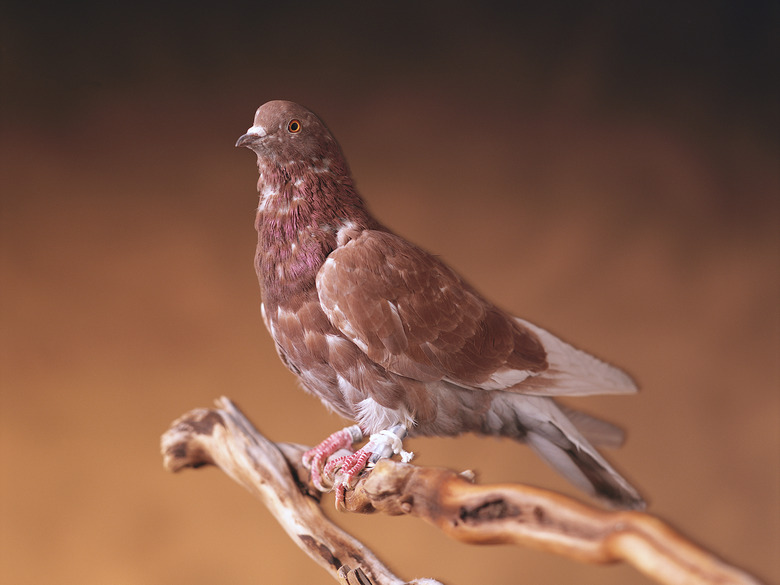How To Find The Owner Of A Homing Pigeon
The sport of racing pigeons goes back centuries; it was first recorded in 200 A.D. Homing or racing pigeons were first imported to the United States from Europe in the 1860s, and in 1872, the first racing club was established. Today there are a number of clubs dedicated to the sport. While wild pigeons have an expected lifespan of only three to five years, racing or homing pigeons are well cared for and tend to live longer, up to 20 years. In 1909, owners started placing bands on their pigeons to help identify to whom the birds belonged.
TL;DR (Too Long; Didn't Read)
A homing pigeon will typically have a band on its leg. The numbers on this band will help you find its owner.
Valued Military Messengers
Valued Military Messengers
Because homing pigeons generally have no trouble finding their way home, even over long distances, their history of being used to send messages dates back to 2500 B.C. Used extensively by the U.S. military during World War I and II, these valued battlefield messengers were used by every branch of the military. These birds were valued, and military documents provide very detailed instructions for their care and training. Each bird was given an identification band on its right leg to indicate its headquarters. Like their human counterparts, military birds rose in rank, moving through class levels, from A-1 to A-5. Any bird not reaching Class A-3 after two years was not allowed to stay.
Banding as a Form of ID
Banding as a Form of ID
Today it is common to "band" birds, either as part of an ecological study or to indicate its home roost. A metal band with identifying information is secured to the bird's leg. Homing or racing pigeons wearing such pigeon tags are likely registered with AU Pigeon or another pigeon club.
Despite their navigational talents, sometimes a pigeon does get lost. Since they use the sun to help them find their way home, under certain conditions, such as when kept under artificial light, they can become confused. If you come across a lost pigeon, the numbers on the band will identify the bird and help you find its owner. While it is in your care, you should place it in a dry box with a bowl of water while you look up its number on the internet and contact its owner. You can also offer it some bird seed or raw grains such as rice or corn. After 24 to 48 hours most uninjured birds should be able to head home on their own.
Pigeon Band Identification
Pigeon Band Identification
The numbers on the bands on homing pigeons that can help you find the owner. To make pigeon band identification easy, each band has a sequence of letters. In most cases, the first indicate the organization that the bird is registered to, followed by a number that is unique to the bird, followed by the letters that identify the actual club and finally the year the pigeon hatched, though sometimes the hatching date and bird ID number are reversed. The following letters indicate which pigeon tags were issued by which club:
AU: American Racing Pigeon Union
IF: International Federation of American Homing Pigeon Fanciers
CU: Canadian Racing Pigeon Union
NPA: National Pigeon Association
In some cases, instead of a code, the band may list the owner's name, address and/or phone number so that you can contact them directly.
References
- American Racing Pigeon Union: Understanding How to Read a Pigeon Band
- Penn State Extension: Homing Pigeon, Lost Pigeon
- Naval History and Heritage Command: Instructions on Reception, Care and Training of Homing Pigeons in Newly Installed Lofts at U.S. Navy Air Bases
- Pigeon Control Resource Center: Everything There Is to Know About the Pigeon
- Backyard Naturalist: One Flew Over the Pigeon Coop
Cite This Article
MLA
Yavorski, Kimberly. "How To Find The Owner Of A Homing Pigeon" sciencing.com, https://www.sciencing.com/owner-homing-pigeon-5798920/. 13 August 2018.
APA
Yavorski, Kimberly. (2018, August 13). How To Find The Owner Of A Homing Pigeon. sciencing.com. Retrieved from https://www.sciencing.com/owner-homing-pigeon-5798920/
Chicago
Yavorski, Kimberly. How To Find The Owner Of A Homing Pigeon last modified March 24, 2022. https://www.sciencing.com/owner-homing-pigeon-5798920/
